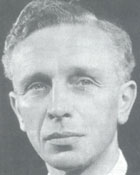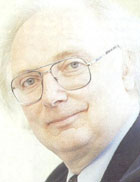2007 Regional Championships - Test Piece reviews
1-Mar-20074BR casts its eye over the five set works for this year's Regional Championships.
 Isaiah 40
Isaiah 40
Robert Redhead
Robert Redhead's composition ‘Isaiah 40' was written as a joint commission through banding organisations in the UK, Switzerland, Holland and Norway and apart from its significance as the test piece for the 1996 National Championships of Great Britain it was the first work allowed by the Salvation Army to be used in such a fashion in its history. Although musically not groundbreaking, its historical and cultural importance to the secular brass band movement cannot be under estimated.
It takes its inspiration from the 40th Chapter of the book of Isaiah, written to encourage people in times of great suffering and change to have faith in the Lord. It's context is both historical (the story related to the problems surrounding the return of the Jewish people to their homeland in the 5th century BC) as well as modern, with the immense changes in society and beliefs the composer himself saw happening at the end of the 20th Century.
The perspective of the work is one of hope: "The Lord is the everlasting God, the creator of the ends of the earth. He will not grow tired or weary, and his understanding no one can fathom. He gives strength to the weary and increases the power of the weak. Even youths grow tired and weary, and young men stumble and fall; but those who hope in the Lord will renew their strength. They will soar on wings like eagles; they will run and not grow weary, they will walk and not grow faint."
In his appreciation of the work written before it was performed at the Royal Albert Hall in 1996, Kenneth Downie wrote that he hoped that the message from which the music took its inspiration was as relevant in the 21st Century as it was in the 5th Century BC. That is undoubtedly true.
The opening bars are perhaps the crux of the work – the baritone voice setting off on the first musical steps to lasting salvation quietly and with some sense of the uncertainties ahead. The thematic material is set out clearly and precisely and returns of course in triumph at the very end. The opening fast section is marked dotted crotchet = 176 – very fast, but not at lightening speed where detail and clarity are lost. The sense of arrogance must not be lost as it sets the picture of Babylon where the Jews had been sent in exile. Try being arrogant when you are babbling like a demented auctioneer on a speed trip.
What follows is a quiet pastorale with the caption: "Comfort ye, comfort ye my people' – a text used by Handel for his famous oratorio ‘Messiah'. It is very transparent music asking much of the horn section as they seek for the desired atmosphere of hopefulness. Much will be asked of the performers for expression – although not slushy sentimentality, as that is too readily an effect dipped into by many conductors. The message portrayed is simple and unambiguous and doesn't need any added bells or whistles to make it any clearer.
The difficult trumpet call section (‘A voice of one calling…prepare…') follows and could provide an error strewn battleground of lost hope for those players who cannot hold their nerve or technique, before a lively section of modernism that requires dexterity and technical prowess.
'The word of the Lord stands forever' is an expressive lament based on the solo cornet theme with underlying baritone accompaniment which builds towards the final section and the triumphant acclaim of the notion that "…they that wait upon the Lord shall renew their strength."
This magnificent tune delivers a spine tingling climax to the work, one that requires a sense of fulfilment as well as majesty – not just loud and hard blowing. Interestingly the main tune in the baritone and euphoniums is marked at the same level (only forte to start) of the rest of the band so balance will be a major consideration especially as stamina wanes in the final procession to the end of the piece. A final brilliant coda reiterates the opening thematic material and a glorious close brings a work of deep significance to a shuddering climax.
 Sinfonietta – The Wayfarer
Sinfonietta – The Wayfarer
Eric Ball
It may sound a touch like sacrilege, but ‘Sinfonietta –The Wayfarer' isn't one of Eric Ball's finest works for brass band. Written for the finals of the National Championships of Great Britain in 1976, it is a work of a tired and perhaps, musically spent man.
The composer himself acknowledged that by the time he had written perhaps his last great work for contesting purposes, ‘A Kensington Concerto' in 1972, the richest vein of musical thought that has blessed our movement was just about mined out of inspiration. That said, even a non vintage Eric Ball test piece is still more inspiring to listen too than the vast majority of other composers who have written for the contest over the past 30 years.
The work has no basic inspiration although you could interpret it as a work based on exile and return (something the composer knew about with his, at times strained association with the Salvation Army). In fact it is technically, and somewhat prosaically straightforward and classical in approach: Three movements of contrast have no related meaning other than the composer's instruction that the listeners themselves evoke a ‘story' from its title. It does not describe any person or series of events even if the suggestion is that of a musical journey of sorts (The Wayfarer being a traveller or passenger).
The opening movement is marked ‘Adventure' (Andante semplicemente) with the composers notating the preamble to the score with the thoughts – "commences quietly, but the peaceful atmosphere is soon shattered by a forceful allegro, depicting contrasting moods of arrogance, gaiety and uncertainty."
The Second movement (although the work is played continuously) is sub titled ‘Exile' and is sad, impassioned, but includes some reminiscence of the peaceful introduction. It was noted by the composer in the programme for the 1976 Finals that this movement puts to the test a band's ability to shape and control wide ranging melodies and to evoke (and also control) strongly emotional moods. There are a few flurries of technical brilliance, and some demanding solo passages. Here, as throughout, timpani and percussion add colour to the scene.
This is the section of the cadenzas for soprano solo cornet and flugel horn and the lovely tenor horn and trombone melodies. A good band should overcome the technical aspects with little problem, but musically it is a different matter – the emotion is understated and subdued, not worn on the sleeve and belted out with tears in the eyes.
The final section is ‘Homeward Journey' as if the protagonist has decided that the period of self imposed exile must end – although there is no indication to why he was exiled in the first place, or to why he must return. It is a rather tired and musically exhausted Wayfarer who makes the trip home, although Ball himself wrote that it moves purposefully towards a final restatement of the introduction, now played triumphantly, and leading to a powerful climax.
In 1976, Ball wrote that to begin, the music takes the form of a Variations on a Ground Bass. Commencing very quietly, and with disarming simplicity, the variations become increasingly demanding, and the final sections call for controlled sustaining power from all concerned.
Some conductors may feel that gives the green light to blow the roof off, but that would be a mistake. It in fact requires for an appreciation of what has gone on before and the need to deliver an appropriate resolution to the musical journey that has taken about 11 minutes to complete from start to finish. Nothing more, nothing less.
'The Wayfarer' proved to be something of an enjoyable yet underwhelming finale to Eric Ball's compositional output at the highest level. A piece of occasional inspired writing, amid rather over familiar thematic ideas, it represents but crumbs from the master's table – although crumbs enough to still nourish the most hardened heart.
Carnival
Helen Perkin
Carnival is one of those hidden gems of a piece that has for far too long been forgotten and ignored. Only occasionally since it was used as the set work for the 1957 British Open has it resurfaced, although luminaries such as Edward Gregson have championed the composer's work over the years (The National Youth Brass Band of Wales performed the suite in 1982 on its first course under him).
Perkin herself was an interesting character. Born in 1909 she is perhaps best remembered as giving the premiere of the John Ireland piano concerto. It would be a touch rich to perhaps say she was a bit of a girl, but she did have her moments and was a bit of a feisty beauty at a time when women in polite musical circles in Great Britain were seen and not heard.
A tremendously gifted pianist and enlightened composer she travelled extensively and was influenced of a variety of composers many of whom took her in completely new musical directions from that of here long time muse John Ireland. As such their relationship broke down, first personally and them musically, although it is suggested that even when they were no longer as close as they once were, it was Ireland who recommended that she write for brass. The result was a small but important output that included not only ‘Carnival' but ‘Island Heritage' which was used at the British Open in 1962.
In its way ‘Carnival' reflects Perkin's earlier ability to write quite beautifully for chamber orchestra – it really is a chamber work for brass band. It is a very English work in style and perhaps owes more to Ireland and his techniques and influence than at first is apparent. When the work was actually written is unclear although academics believe it to have been originally sketched some years prior to its use at the contest.
The work is broken into three distinct movements:
'Cavalcade' is fresh and breezy although it does change in character quite quickly demanding sensitivity, balance and an appreciation of subtle tone colours. There are some unexpected harmonies and rhythmic effects too although the strong sense of melodic content remains secure throughout. It would be harsh to say that it is over conservative in style, perhaps more David Cameron than Anne Widdicombe but as a cavalcade (a procession on horse back) it is more a rural gymkhana than rodeo drive.
The slow and reflective ‘Pavane' is a gem though – a subtle and lyrical exposition of melancholic thought and execution. It's all about balance and style, subtle colours and understated emotion. The solo lines are demanding but not overly difficult for players with a sense of style about them whilst the percussion is used with a lovely sparing touch – just enough to add colour and pulse. The final couple of bars will certainly sort out the wheat from the chaff.
The finale ‘Burlesque' is a bit of a hearty romp – although it should not be dumbed down like some sort of Z list Celebrity Come Dancing by trying to inject misplaced excitement, overblowing or harsh tones into the playing. Everything is set out with a purpose in mind, even if it is a touch carefree of spirit and intention and it all comes to a very neat and tidy conclusion.
‘Carnival' is music very much of its time and place, but also from the pen of something of a free spirit. It's a fine choice and one to enjoy.
 Prelude & Jubilate
Prelude & Jubilate
Darrol Barry
Written originally as just a Prelude to celebrate the 10th anniversary of Ensemble de cuivres d' Anjou in Switzerland 2001, Darrol Barry has since expanded the short work to include the Jubilate. It is a work that has all the composer's enjoyable hallmarks of lyrical melodies and rhythmic perkiness throughout and although the two parts were written at separate times they compliment each other impressively.
The opening ‘Prelude' is marked Lento, Chrotchet = 60 and will require a steady nerve in the soprano and solo horn to ensure things get off to a good start. If there is any sign of poor tuning the whole atmosphere of the opening few bars will be lost amid a collective feeling of fingernails being drawn down an old school blackboard. The short motifs that follow also require care and attention before it gets decidedly livelier with the following Allegro deciso and the ‘Jubilate', marked up at chrotchet = 160.
Here the players can enjoy themselves whilst the MD will have to be careful not to let things run away with themselves as well as making sure there is clarity in all the main solo lines. There is a great deal of detail on show in the score that can only be realised if care and attention is taken with dynamics and tempi. There are some clever little ideas running along throughout this section of the piece, and each of the main solo instruments has an important part to play – sometimes at length sometimes with just a tiny little motif and interjection.
As always with Darrol Barry works the percussion are given plenty to do – and not just in helping things along by offering rhythmic pulse. Bands will have to have pretty competent tuned players to meet some of the demands on show and also players with a bit of intelligence to know when to feature and when to hide.
There are some nasty little tempi and time signature changes in places too and it will be interesting to hear if conductors take the opportunity to temper enthusiasm towards the end in a bid to maintain stamina and control. There is a long old ride for home with the real pitfalls for bands of trying to make something out of nothing. The final few bars will see if the best bands do have something in reserve and can round things off with a real flourish.
This is a great little piece for the bands in the Third Section and one that should test them to the full. Not too technically difficult with enough musical rope for the conductors to either lasso a victory or hang themselves instead.
 The Seasons
The Seasons
Philip Wilby
The Seasons is a cracking suite for brass and will give all the bands in the Fourth Section a real chance of bringing something out of the music.
Written in 1998 it was first used as a major set work at the Fourth Section National Finals in 2000 where it proved to be a very popular choice. The piece itself was commissioned by Ian Thompson in memory of his wife Myra, and as the title suggests the work traces the seasons of the year – although the keen eyed player will have noticed that there are only three movements, not four.
Philip Wilby covers that by noting that the music traces the year's change (not just its definable seasons) from what he says is a cold, late autumn to an indoor winter, through a spring waltz to a final open air march. His aim was to provide music which is both enjoyable to rehearse and perform but not forbiddingly difficult to play. He has of course succeeded splendidly.
Philip Wilby is very clear about the inspiration behind each of the three movements. Movement 1 – Turn of the Leaf: Prelude and Dedication he states, opens quietly. "It is autumn through to an indoor winter. The music unfolds with brief appearances for soloists and subtle colourings in the scoring. The key changes and a tender melody first shared by flugel and euphonium is picked up by the solo cornet. The music builds to a climax then, just as suddenly, thins out, eventually fading into a whisper."
It is a lovely little movement – transparent as a dewdrop on the score but crucially asking the conductor to ensure balance and warmth and good basic tuning. It is atmospheric and melodic, but also technically much harder to make come off than you would expect from just looking at its construction. The last chord will tell you everything you need to know if a band is going to do well or not on this piece.
It is not often bands get to play a waltz in a brass band contest at any level, so it will also be interesting to see how they cope with the second movement – Spring Waltz. As Philip himself says: "The waltz changes the mood. The waltz is led by the solo horn, joined later by the soprano. The pace increases and solo trombone takes the lead, followed by the horn family. Still the tempo increases; upper cornets, trombones and euphonium have the melody until the tempo abates. The flugel tune returns at the original tempo, but it is the solo horn who closes the movement with a seductive twirl."
The secret of the movement then is all about pace – start to quick and you will be dancing the jitterbug when the tempo asks to be notched up a degree or two – too slow and it can become a deathly dirge. The composer has allowed the MD that choice of rope to play with in the marking a tempo flessibile – but some may well hang themselves we are sure. A waltz is a dance with a very discernable rhythmic pulse – pulling it around too much will mean bands stepping on their partners toes.
Finally the third movement – High Summer: Marziale. Philip writes: "This opens in unison with a strong rising tune and fanfare like figures leading to typically martial music. Horns arrive with a broad melody which later give sway to more vigorous, jaunty music. There is a return to the broad tune, this time in euphoniums and cornets. Trombones and lower cornets respond with the jaunty tune adorned by fanfare figures. The music is fortissimo – everyone has a great time until it all slows down to let the music thunder to a broad triumphant close."
You can't any clearer than that can you? So if the bands and conductors have something in reserve and have not blown all their stamina away then they can look forward to rounding off their performance with a real sense of style.
Philip Wilby has written a corker here and we are sure it will be enjoyed by everyone.















